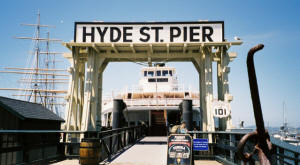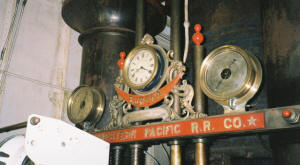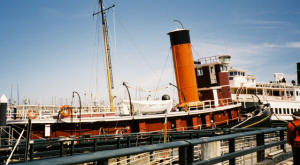| RyPN Briefs June 25, 2005 |
|
|
If You're Going to San Francisco.....
OK, I didn’t actually wear flowers in my hair, but I did visit on May
22-24, in transit to Alaska, and caught up with frequent contributor Ted
Miles, who was kind enough to take a couple hours out of his busy day
running the San Francisco Maritime National Historical Park to show me
around his steam railroad collection.
His steam railroad collection is unusual, since it floats.
We started out in the Northwestern Pacific Railroad ferry Eureka. Built
in 1890 as railroad car ferry Ukiah, she was heavily rebuilt and altered
in 1922 and became the largest passenger and auto ferry on San Francisco
Bay. The original walking beam engine and sidewheel configuration was
preserved in the 1922 rebuilding, and, apart from minor modernizations,
she was altered very little during her working career, which ended in
the 1950’s.
Casual visitors will enjoy exploring the accommodations – nothing
special in 1922, but certainly demonstrating materials and craftsmanship
not found on working craft today in terms of the woods used and
carpentry. Just shy of 300 feet in length, she is the largest wooden
boat afloat, each bit of wood hand fitted. National Park Service
recently finished repairing some deteriorated structure by replacement
in kind, and the repairs blend invisibly into the original structure.
The collection of vintage cars and trucks on the deck will also interest
non-railfans.
The engineering spaces below decks are not normally open to the public
but are fascinating to behold. The walking beam engine (as well as all
the auxiliaries) were powered by return flue fire tube boilers having
corrugated cylindrical fireboxes completely surrounded by water. Exhaust
steam was condensed and recirculated through the boilers to limit the
supplemental fresh feedwater requirements. Reciprocating steam dynamos
supplied power for the ships electrical systems. These dynamos and a
variety of pumps and a couple miles of piping provide many opportunities
for visitors to the engine rooms to acquire concussions, so it is only
available for visiting by special arrangement with a guide from site
staff.
The steam tug Hercules is the archetype for the classic ocean going tug
– a big engine with a hull around it, high funnel, and raised pilot
house with semicircular front. At 139 feet, she is larger than the
classical New York Central harbor tugs you mentally associate with
railroad tugs, but much along the same lines in conception.
Hercules was never designed to carry passengers, but was built with
finer woods and craftsmanship than many passenger vessels of today,
although not quite as fancy as Eureka. She was built in New Jersey in
1907, and until 1924 worked the West Coast towing barges and log rafts
between the Pacific Northwest and the Panama Canal before being
purchased by the Western Pacific Railroad to shove car barges around
San Francisco Bay.
Her engine room is filled with a big triple expansion up and down engine
– sort of like a compound Shay engine that got lost at sea. The cylinder
heads are about level with the deck. Auxiliaries surround the engine in
the spaces against the hull, leaving a narrow walkway between. Again,
the area is hazardous, so visitors are limited to viewing the engine
room from deck level. To gain some insight as to life in the engine
room, visitors can play a tape loop recorded in the engine room of the
sound of the boat under way.
In was extremely impressed with Hercules condition – you could fill the
boiler with water, throw in a match and take her out to work a full day
anytime. I’d be proud to volunteer as oiler, or wiper, if they do.
Apart form these two railroad boats, the park has several other sailing
and motor craft on display also at Hyde Street Pier, as well as a couple
other locations. The sailing ships Balclutha and C.A. Thayer, schooner
Alam, and various small craft are found at Hyde Street. The submarine
USS Pampanito shares a pier with the Liberty Ship Jeremiah O’Brien at
Pier 45, and the archive and library is at Fort Mason.
Another steamer, the Eppleton Hall, resides at Hyde Street, but is in
poor condition awaiting restoration and not on display to the public.
She is a British sidewheel harbor tug, which somehow survived a 1969
trip across the Atlantic, sucking boiler water from the sea, with her
boiler carrying 35 pounds of steam! And we question railroad
preservationists sanity……..?
The park has recently opened a beautifully done new visitors center
facility across the street from Hyde Street Pier – the berthed displays
back down the pier don’t present much in the way of streetscape to
attract impulse visitors, and it is hoped the new Visitors Center will
divert more of the passing tourist parade into the park. Most of the
exhibits were in place during our visit, and everything was very well
and professionally done. The gift shop on the pier has something I wish
I found everywhere - a special shelf with used books for sale, the
proceeds of which were earmarked for the library and archive. Hard to
walk away empty handed.
NPS policy prevents Ted from blowing his own horn, which is a shame –
thanks to him and to his staff, and pleased to toot a bit on his behalf
here. Railfans and steam fans will find a lot worthy of visiting there,
and it has broader appeal as well that will perhaps help when traveling
with less enlightened family members that may not share our appreciation
for rusty iron on flanged wheels.
Other crossover attractions in the area I wouldn’t miss are the
Exploratorium,
cable cars and trolleys – the entire public transit system
is available for $6 per day, less than the cost of parking, assuming you
could find a space, which you can’t. Good microbrews at Gordon Bierstadt
by the ballpark and old Belt Railway roundhouse, and fine Chinese
cuisine at many mom and pop joints like U-Lee, which offered tons of
great food at bargain basement prices. Try the hot and sour soup and potstickers, you won’t regret it.
I understand there is a
railroad museum in San Francisco, but oddly
enough didn’t see the first brochure in any of the tourist venues I
visited that might have told me where they were, when they were open, or
what they had to offer. Oh well, maybe next time I am on the other
coast, whenever that may be.
(Dave Lathrop)


